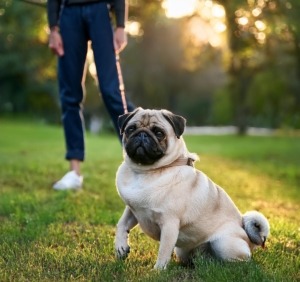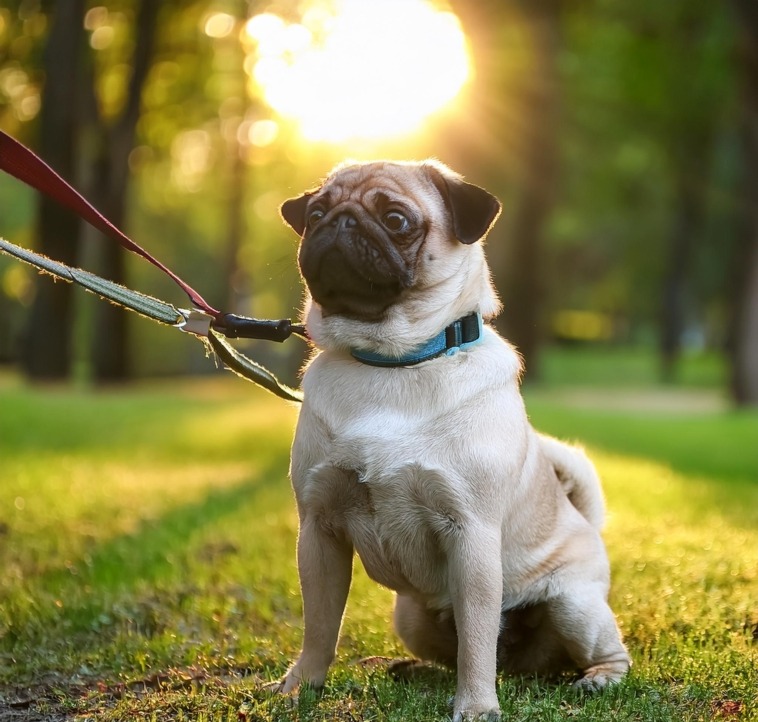Last updated on October 24th, 2024
Here’s an overview:
Important Tools for Training a Pug
Addressing Common Pug Behavioral Issues
Training for Specific Situations
Maintaining Consistency and Patience
Fun and Engaging Training Activities
Health and Diet Considerations
Working with Professional Trainers
Introduction to Pug Training
Training pug puppies can be challenging, as they require focus, consistency, and an approach that fits their particular character. Pugs are friendly, loving creatures who are very eager to please therefore generally, it is easy to train them.
Key Points to Consider
- Start Early: You should start the training as soon as you take your Pug home. Puppies can accept changes easily and can be trained quickly.
- Positive Reinforcement: If your Pug does something good, treats or praise should be given while physical punishments are to be avoided since the Pug is an emotional creature.
- Consistency: Form a habit of doing everything in a certain pattern in order to facilitate learning. Short, frequent sessions are more productive than grueling long ones.
- Socialization: Your Pug should be introduced to different surroundings, human beings and animals in order for him/her to build up self assurance while lessening worries.
Understanding Pug Behavior
Behavioral characteristics of Pugs need to be appreciated in the course of training. Pugs are friendly, loyal and are dependent on humans for most of their activities. Apart from the sleeping, the Pugs are famous for:
- Desiring fun: Pugs are fond of engaging in activities that are fun when they are awake.
- Wanting their way: They are quite willful and training must be strictly followed.
- Being too much of a softy: They are prone to injury by strong reproofs and therefore re-enforcement is very important.
- Being bright: Although they can be trained very fast, cleverness makes them too cunning.
For the purpose of correcting the unwanted behaviors, it would be helpful to:
- Engage in cohabitation with the neighboring dogs.
- Adhere to regular habits that are of short periods.
- Emphasize positive reasons for certain actions.
- Restrict their permanence outside the house.
Important Tools for Training a Pug
1. Leash and Harness
If a harness is used, it should be well-fitted and keep the Pug snug whilst on a walk. For efficient control, do not exceed a six-foot leash.
2. Clicker
Clicker training aids in positive behavioral paradigm. The sound makes the dog aware that the correct action has been executed and hence more training can be achieved effectively.
3. Treats
Some of the rewards are the moderate-size, undemanding, and under quota treats. Make sure that the dog treats selected are by nature for dogs in order to avoid complications.
4. Toys
Toys help in keeping a Pug’s attention or average interaction level very high. Such toys will come in handy when you are having training sessions.
5. Training Pads
Training pads do assist the puppy in house breaking. They are most beneficial to Pugs puppies and they limit accidents when on training.
6. Whistle
A functional training whistle can be used when instructing commands to come and its variations. There is a guarantee that the Pug also comes towards the sound.
7. Training Books
There are various kinds of books about Pug training where a prospective owner can gain a lot of knowledge regarding dogs and the step-by-step techniques to assist them. Such books are beneficial to both new and old owners.
Housebreaking Your Pug
Housebreaking a Pug means being consistent without any deviations. A schedule must be created for taking the Pug outside to relieve itself at the same times every day such as after meals, waking up, and before bed.
- Select where the toilet should be placed on the lawn.
- Use the phrase ‘go potty’ or similar phrase so that the pug will associate words with doing the deed.
- Praise the Pug or give them a small snack as a reward immediately after they have finished.
- Be brief and to the point in the sessions.
- Monitor indoor activities and restrict movement to specific areas.
- Use a crate for the unsupervised times.
There should be no trace of such mess and any helper should make use of the enzymatic cleaner for effective cleaning.
Basic Obedience Training
In order to achieve basic commands when training a Pug, training programs will need structure, discipline and a lot of rewarding. Start with the easiest orders to follow.
- Sit: Raise your treat so that it is above the pug’s head and then retrieve it towards you in backwards motion. As soon as the bottom of the dog contacts the ground. say sit and give a reward.
- Stay: Once the dog has sat down and you ask them to ‘stay’, let the dog stay whilst you step a few feet away. After a few seconds of remaining still, the dog can be rewarded.
- Come: You will want to start with a leash. First say the word ‘come’ and then slowly pull on the leash in your general direction. Once the dog is close enough to you give them a treat.
- Treat on the ground. Position the Pug to follow the hand as it goes to the ground while saying ‘down’.
Consistency is one of the most important factors when training.

Advanced Training Techniques
Clicker Training
Clicker training is often used to reinforce good behavior in a dog. A clicker is a small device that makes a sound. It is typically handheld and is used to mark a behavior before reinforcement follows.
Target Training
Target training is the use of a specific object such as a stick or a spot to move the Pug’s body where only its head is directed. Increasing movement away from the contact and difficulty in offering the Pug a specific command improves his obedience.
Proofing Behaviors
Establish proof for behaviors by rehearsing the commands that have been given in the presence of various counteracting factors. This helps ensure that the pug will be able to correctly respond to a command at any time, as no two situations are identical.
- Regular practice
- Positive reinforcement
- Distraction command
Addressing Common Pug Behavioral Issues
Excessive barking
With a frequent course of pleading, pugs do bark too much when they feel quite bored or are anxious. Engaging in active play holds it most important. It is also essential to let them meet and train with people and dogs.
Separation Anxiety
Separation anxiety appears in pugs a lot. Leaving comfort items and gradual desensitization including soothing things like clinically proven banana chips are helpful for prunes.
Stubbornness
Sometimes going through some obedience training can be quite challenging for the pug since they can be very stubborn. Compliance becomes easier with the introduction of positive motivations like treats and praises. Regularity of the training is of great importance.
Chewing and Destruction
Chewing is one of the most common problems. Give them barely chewing toys, and restrict them to various interactive toys for a while. Be sure to give them persistent corrections when continuing on the wrong path – in this case, unwanted chewing.
Housebreaking Difficulties
Potty training can be a hard task to accomplish. Follow a schedule, crate train and reward in order to develop a good pattern.
Socializing Your Pug
For a pug to be happy and well behaved, a lot of emphasis needs to be placed on socialization. To develop the dog’s self confidence and eliminate anxiety, enough exposure to different places, people and other pets should be ensured. Follow these steps:
- Start Early: Allow them in as much variety of new experiences as possible while they are still young.
- Controlled Environment: Start in a familiar and well controlled environment to avoid flooding the puppy.
- Positive Reinforcement: Use treats and praise to reinforce acceptable behaviors.
- Regular Playdates: Get familiar with the dogs so that the pug has friends to socialize with.
- Enroll in Classes: Take puppy socialization classes for course repetition as well as better skills.
“Usual socialization that begins early and continues on is very important to lead the pug into adjustment.”
To have the benefits last, these practices should be frequently repeated.
Training for Specific Situations
Training a Pug for specific situations requires preparation – a Plan B strategy. Because Pugs are exposed to many different kinds of situations, they will sometimes need to be trained in special ways.
- Socialization: Let the Pug out in different surroundings, see other people, and other animals. Make use of treats and other rewards to foster enjoyable experiences.
- Housebreaking: There should be a defined timetable for when the dog would be allowed to go out for bathroom breaks. Reward the Pug immediately once He has finished relieving themselves outdoors.
- Leash Training: Make the Pug learn to walk beside the owner with a minimum of pulling. Apply a harness and reward uprightness.
Training is essential to make sure that your Pug adjusts comfortably to the varying conditions.
Maintaining Consistency and Patience
Success in making the training a success relies solely on patients and the prevailing conditions that will aid in making the what is intended happen. Pugs are stubborn but affectionate dogs that must be worked with:
Consistency:
- Use the same commands and rewards to avoid confusing the Pug.
- Frequency of the training should be determined.
- Rules should be the same for everyone to avoid different messages.
Patience:
- Realize that you will make slow progress, and do not become angry.
- In low instances reward every little progress.
- You will and not get angry whenever things don’t quite go to plan, since this is also a phase of training.
Repetition and gentle persistence every time help o create a bond with Pugs as well as teach them.
Fun and Engaging Training Activities
Training process for a Pug can be greatly improved by providing various, interesting activities. The following activities should be added to make the training process both useful and fun:
- Treat-Based Training: Positive behavior is rewarded with treats. This is a motivating factor for the Pug.
- Agility Courses: Create small obstacle courses outside for the little ones. Pugs like to be active.
- Puzzle Toys: Use puzzle toys to keep the mind of the Pug busy. This aids in increasing the mental abilities.
- Short Play Sessions: Take a break from training and play for a little while. Activities like fetch, or tug leash serve as fun and obedience.
- Interactive Socialization: Arrange for other dogs to come around for a play date. This enhances socialization.
Health and Diet Considerations
For effective training, there should also be good health and diet. Pugs are overachievers on the food scale, people that keep the dogs can attest to this and immobility will do the Pug no good.
- Balanced Diet: Good dog food should be high in protein. Refrain from feeding anything that has preservatives.
- Portion Control: Measure all food that is going to be fed so that nothing remains to feed the dog. All treats should be small.
- Hydration: Keep fresh water nearby at all times.
- Regular Checkups: Do not slouch on veterinary check-ups since it will focus on weight in addition to general health.
- Exercise: Strolling and primarily light-hearted play in addition to training should be utilized.
- Special Dietary Needs: Pay attention to specific foods that cause irritation or allergic reactions.
Following these standards guarantees a pug healthy, and most importantly trainable.
Training an Older Pug
Training an older Pug is not an easy task – it needs patience and perseverance. Here are the steps to follow:
- Establish Trust: Cuddle with the Pug so that the Pug can familiarize herself with you.
- Be Consistent: Utilize the same commands and rewards.
- Positive Reinforcement: Bear in mind to give them something as a sign of appreciation for good behavior.
- Set Short Sessions: Limit the time one spends with the pug during training.
- Gentle Commands: Use a soft voice rather than shouting.
- Adapt to Needs: Consider health conditions while training.
- Repetition: It is crucial to repeat frequently the orders.
Older Pugs can still learn new tricks provided one uses the right approach towards their training.
Working with Professional Trainers
Hiring a professional trainer may change the dynamics of the pug’s training experience dramatically. Trainers have the knowledge and tested methods making the process faster and fun. Some advantages are:
- Expertise: They work out basic behaviors thatpugs make in order to customize the techniques used.
- Structured Programs: They offer logical strategies and ensure such strategies are continually undertaken.
- Positive Reinforcement: There are some practices that undermine the adoption of using punishments that has been the practice over years by non professionals.
- Behavioral Insights: Trainers help in addressing many other types of behavior, such as fears, depression, or other types of aggression.
Owners should research and choose certified trainers who are experienced in handling small breeds such as pugs. Regular communication with the trainer helps to keep the projects aligned and achieve the best results.
Conclusion and Final Tips
This is an important step, as relentless training, patience, and treats are all needed in order to teach the pug correctly. Keep your dog occupied by using short training periods so he does not get bored or lose his concentration. Include several kinds of activities in the schedule so that both physical and mental sides can be engaged.
- Consistency: Call for the same actions and follow the same command projections.
- Positive Reinforcement: Praise and treat reinforcements should be given for performing actions in accordance with the required behavior.
- Socialization: Allow the pug to come with different surroundings and people.
- Patience: Acknowledge that every pug is inclined to learn at a limited capacity.
At all times a pug should be watched carefully for any signs of stress and possibly overworking. Make sure to make time for appropriate training and enjoyable playtime to develop that necessary emotional connection.
Article from: Abdullah (Senior Trainor)




